QuestionQUESTION: Hi - we've had our gecko for about a month. He generally at between 4 to 6 small crickets a evening. He started to shed last friday (today is Wednesday) and hasn't eaten since. We've helped him with his shed gently rubbing it off using warm water. We tried both crickets and mealworms - but he won't eat. We've left crickets in overnight hoping he would eat at night but the next morning they are still in the cage - so we took them out. He has had droppings. The crickets will walk right up to him but he has no interest!
He's in a 10 gallon cage (which we now realize needs to be bigger) - he has a warm side (between 85 and 95 during the day)and a cooler side. Will a peat moss hiding hole on the cool side. We've tried changing things around to give him the best enviroment but are afraid that we are now stressing him out. He currently stays primary in his hiding hole on the moist peat moss. He has a shallow water dish.
How long can he go without eating? What do you suggest to get him to eat? Any suggestions?? Please help!
The Goshorn Family!
ANSWER: Hi Michelle,
The 20 gallon breeder tanks are much easier to give them their needed temperature zones which makes it a better choice for housing a single or even two leos.
He really isn't eating much at all..as most leos will eat a dozen or so crickets.
Two common causes of not eating are..1. crickets too large. be sure the crickets are no larger than the space between his eyes..offering smaller ones is even better!!
2. Incorrect temperatures. Leos are ground dwellers therefore need to have bottom heat. The easiest to do this is to use an undertank heater. You want this to cover 1/3 of the tank.
Even though your air temp may be warm, the floor won't be. I would add the UTH and see if that helps. I am including a basic care sheet that I wrote to help people out with care.
If he does not eat in 10-15 minutes, remove the crickets so as they don't nibble on your leo. Just to be safe,place a cut potato or carrot in the tank. The crickets will eat the potato(or carrot) instead of the leo.
As long as he has a nice fat tail and is drinking, they can go quite a while without eating without any problems.
If, after adding an under tank heater and making any other needed changes you can try not offering any food for 2 days..then offer the crickets. if the crickets jumping is what is causing him to not want to catch them, you can break the hind legs on the crickets. Also, you may try offering him one of the other suggested insects. if you dust his insects, try not dusting them to see if he eats them. As you see, it is a process of elimination. If he still doesn't eat after all corrections, and different suggestions, then a vet visit is recommended to check for internal parasites.
They can go off food when shedding as they do eat their shed..generally, a good shed on a leo is almost all in one piece. If he is shedding in bits and pieces, its best to offer the humid hide on the warm side, and this is another reason why the undertank heater is necessary..it keeps the moist moss warm to aid in the shedding.
BASIC CARE FOR A LEOPARD GECKO
Leopards are pretty easy to care for but they do need
special care. Here are some of the basic needs of your gecko.
HOUSING: The need to have at least a 20 gallon long tank for one Leo. This needs to have a secure fitting screen top...they can be quite the escape artists!!! They need to have a humid hide box.You can make this with something as simple as a small plastic dish with a hole cut in one side and a small mesh bag filled with some Sphagnum moss coconut bark or Peat moss that you mist.
I made mine out of the small plastic folgers coffee containers...I cut an opening in the lid..and put the moss in..they LOVE it. I use the terrarium moss in mine.
I use that on the warm side of the tank. Be sure to provide a cool hidebox on the other end. I also provide a mid temperature hide...which is in the middle of the tank.I use the critter caves which you can purchase. NOT the ones that have heat in them!!!!
Provide secure climbing areas for your gecko. Fake plants, rocks and branches are all fine to use. be sure there are no wires or sharp ends to any fake plants you use.
*****SUBSTRATE:(that's the stuff on the floor of your tank) Newspaper, lizard carpet or paper towels work great and are easy to clean and are much safer than any loose substrate. Sand or other loose substrate is not recommended as that they can be deadly to the leo when it is ingested(eaten, even by accident while eating their insects)...A very graphic site of an impacted leo surg can be seen at http://homepage.mac.com/exoticdvm/reptile/PhotoAlbum181.html it is very graphic!!! ******What I have found that works great for safety and heat distribution is using about 1/4 inch of childrens play sand(since the tiles fit tight together, there is no sand danger) on the bottom of the tank and on top that you place ceramic or slate floor tile. What is nice is that the 12 x 12 squares fit perfect in a 20 gallon tank with no spaces between the tiles. The sand and the tile distribute the heat wonderfully. Using the under tank heater as described is what distributes the heat. Also, overhead heat will help in heating the tiles...I've been using this set up for several years and the leos love it. Using a tile that isn't smooth is recommended. **********
TEMPERATURES: They need a warm area ( on the floor) of 88-92 degrees and a
cooler area in the upper 70s, low 80s. At night their temperature can drop to the low to mid 70's.
Never use a hot rock for a leopard gecko...or any reptile.
They can severely burn any reptile. You can use a heating
pad under the tank,under tank heater for the warm area. You can use a regular household lightbulb in a dome fixture with a ceramic socket in it to keep the warm area at the 88-92 degree area if needed there, otherwise, placing the lightbulb about midway in the tank will give the needed temeratures throughout the tank. You may have to play with the wattage of the bulb but generally 40-60 watts is sufficient.At night, no white light. If room temperatures stay above 70 degrees, no extra night heat is needed. The undertank heater or heating pad should cover about 1/3 of the tank....be sure to raise the tank up about 1/4-1/2 inch off the stand when using an undertank heat source to prevent heat build up which can cause the glass to break and hot spots in the glass. Be sure to have a good layer of newspaper, carpeting or, even a thin flat rock(such as tile) on top the area that the undertank heat source is placed...if you use a thin rock or tile, it helps to distribute the heat very well.
You can use the special nighttime lights that are designed for reptiles. I like using a ceramic heat emitter on a thermostat for nighttime heat.
DO NOT use black lights or party lights as they can cause eye damage!!!!
The wattage you use will vary based on room temperature and size of tank.
LIGHTING: Leopard geckos do not need UVB lighting but it does not hurt them to give them uvb. They should have some type of light during the day, be it a uvb tube, regular florescent light, reptile day light or regular household lightbulb. NO white lights at night!!!
FEEDING: Geckos should not be fed crickets or other insects that are bigger than the space between their eyes. Generally, hatchlings can be fed more than once a day,juvys can be fed twice a day, adults are fed once daily or every other day, in the early evening. Crickets and other food items such as silk worms, super, and an occasional treat of a wax worm, need to be dusted with a calcium supplement two times a week and also they should have a small dish of calcium in their tank. I use the lid of a milk jug for the little dish of calcium in their tank. For dusting the insects, Use a calcium with no added phosphorus. Insects must be gut loaded(fed) for at least 48 hours prior to feeding your gecko. Remove any uneaten crix or superworms after 15-20 minutes..... Place a piece of cut potato in the tank so that if you have missed any uneaten insects, they will eat the potato instead of nibbling on your gecko!!!
*************You have to be sure to feed your crickets and insects the right foods before feeding them to your gecko. If your crickets/insects are not healthy and well fed, your gecko will not get the nutrition he needs. You can gut load your crickets and insects greens, veggies, cereals or specially designed commercial foods for crickets or the insects you are feeding. ************
Be sure to have a small dish of clean water for your gecko at all times!!
You can offer them some baby food or fruits on occasion ...
Mine will even eat a small piece of watermelon now and then.WATER: always provide a dish of drinking water. If you choose to mist your gecko to drink, its best to not get the tank too wet as that they do not do well with higher humidity. Sometimes its better to take your leo out of their tank to mist them to get them to drink!!!
HANDLING: Some geckos enjoy being held...others prefer not to be handled at all. Be sure to be very gentle when holding your leo and NEVER grab them by the tail! Their tails are extremely fragile and will break.
I do suggest finding a vet that can treat reptiles BEFORE you actually need one!!! To find a vet that is able to care for reptiles:
http://www.herpvetconnection.com
http://www.arav.org/ECOMARAV/timssnet/amm/tnt_mdsearch.cfm
http://www.anapsid.org/vets/
For more information on leopard geckos:
http://www.drgecko.com
If you have any questions or don't understand something, please let me know.
---------- FOLLOW-UP ----------
QUESTION: Thanks Diane -
We are going this weekend to get a bigger tank and include your suggestions. We do have an undertank heater - but we moved his humid hide spot back to the warm side. He has started eating a little and is still having droppings. We now think it's the crickets moving that throw him off. Last night he ate 5 crickets that we hand fed them - (my son held the gecko and my husband had the cricket and the gecko snapped and got the cricket) Obviously if he needs 12 crickets a day we'll do that now twice a day - Should we put the crickets in the cage first and see if he'll eat them and if he doesn't after 15 minutes - hand feed him? While he's doing a lot better his tail is still skinny compared to when we got him. The pet shop had told us 5 small crickets once a day. So now we are going to do 6 crickets 2x a day - Is that a good idea?
Thanks so much for your help!
AnswerHi Michelle,
Glad to hear he is eating a bit better. I would try breaking the legs on the crickets to see if he will eat them that way. Something else you can try is to use his old tank for a feeding area. That way, there is nothing in it where crickets can hide and your leo may decide that chasing the crickets is easier.
You want to feed him as many crickets as he can eat in the time frame. I would not leave crickets in the tank with him after the time frame. Lizards can be a pain as they get spoiled and won't eat unless hand fed..its something we try to avoid at all costs, so do see if he will eat on his own first, either in his new tank or using the old one as a feeder station.
His tail will take a bit of time to get fat again as that right now he is using everything he eats nutritional wise. You can try offering the crickets 2x a day, but if you find him loosing interest, I would only feed in the evening or offer less in the 1st feeding. As they get older, many will only eat every other day, but hatchlings and juvies are generally 2x a day or 1x a day.
Be sure to feed the insects well before offering them to your leo so that he is getting the best possible nutrition from the insects. Generally, 24-48 hours of "gut loading" is good..so buying the crickets in bulk is recommended. As per the care sheet, using many household foods work for the gut loading.

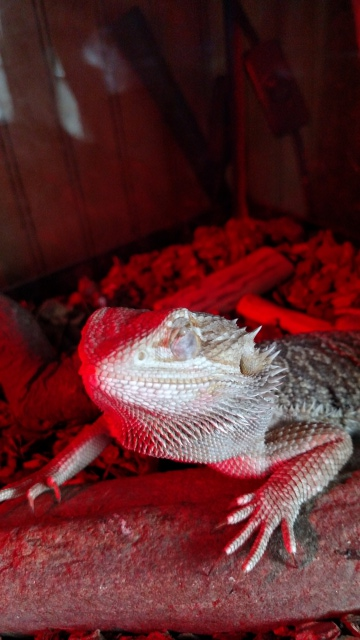 Dragon bearded reptile
Question
Eye Other eye
Same person here wi
Dragon bearded reptile
Question
Eye Other eye
Same person here wi
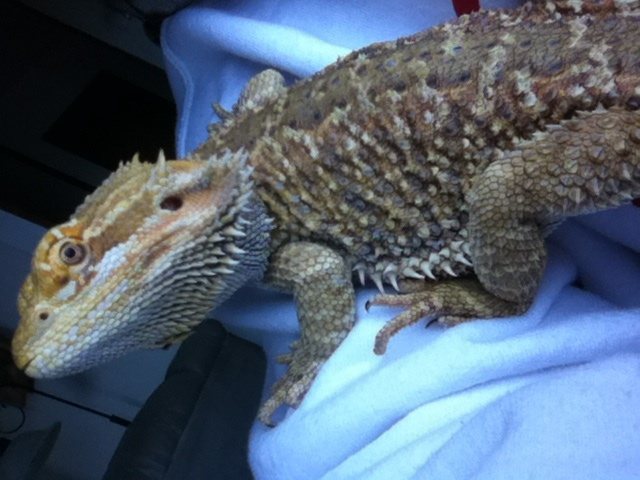 My 9 month old beardie
QuestionOscar
Oscar
QUESTION: My boyfrie
My 9 month old beardie
QuestionOscar
Oscar
QUESTION: My boyfrie
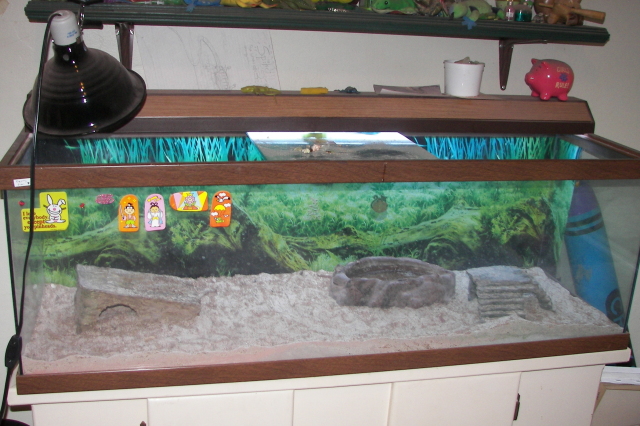 bloody mass hanging on the rectum of our bearded dragon
QuestionQUESTION: Hello Tracie,
Yesterday evening our d
bloody mass hanging on the rectum of our bearded dragon
QuestionQUESTION: Hello Tracie,
Yesterday evening our d
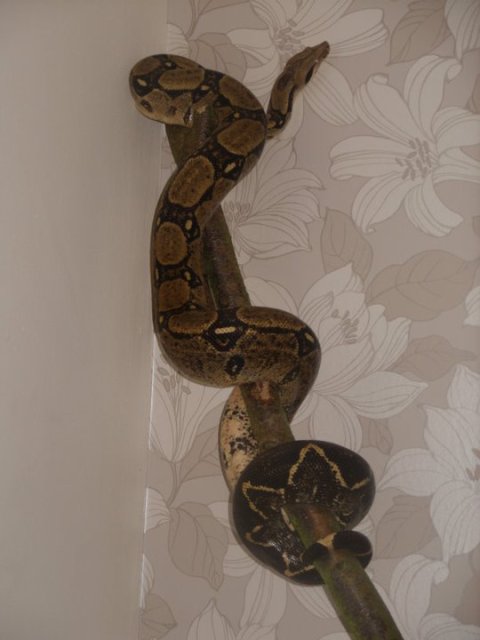 boa behaviour change
Question
Tink Our Snake
Hi, we have what we think is a
boa behaviour change
Question
Tink Our Snake
Hi, we have what we think is a
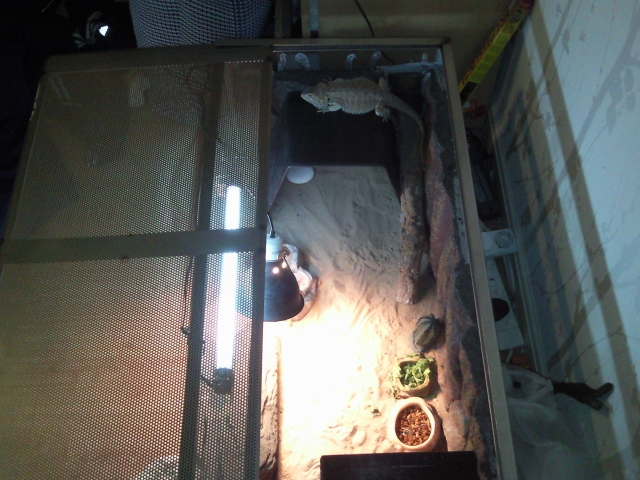 not sure if my beareded dragon is ok?
QuestionQUESTION: hi tracie, i have read loads of Q&As
not sure if my beareded dragon is ok?
QuestionQUESTION: hi tracie, i have read loads of Q&As